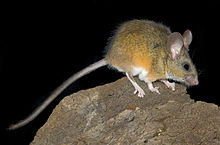California deermouse
| California deermouse | |
|---|---|

| |
| Scientific classification | |
| Domain: | Eukaryota |
| Kingdom: | Animalia |
| Phylum: | Chordata |
| Class: | Mammalia |
| Order: | Rodentia |
| Family: | Cricetidae |
| Subfamily: | Neotominae |
| Genus: | Peromyscus |
| Species: | P. californicus
|
| Binomial name | |
| Peromyscus californicus (Gambel, 1848)
| |
The California deermouse or California mouse (Peromyscus californicus) is a species of rodent in the subfamily Neotominae in the family Cricetidae. It is the only species in the Peromyscus californicus species group. It is found in northwestern Mexico and central to southern California. It is the largest Peromyscus species in the United States.[2][3]
While most rodents are
Description
The California deermouse has very large ears, and its tail is longer than the head and body combined. Including the tail, which is about 117 to 156 mm (4.6 to 6.1 in) long, the mouse ranges in length from 220 to 285 mm (8.7 to 11.2 in).
Breeding
The California deermouse is semi

Behaviour
P. californicus is more strongly territorial than
Diet
The mouse's diet consists of shrub fruits, seeds, and flowers, such as of
Predators
Their main predators are weasels and barn owls.[23][24]
References
- . Retrieved 17 November 2021.
- ^ JSTOR 1373853.)
{{cite journal}}: CS1 maint: numeric names: authors list (link - ^ Musser, G. G. and M. D. Carleton. (2005). Superfamily Muroidea. pp. 894–1531 in Mammal Species of the World a Taxonomic and Geographic Reference. D. E. Wilson and D. M. Reeder eds. Johns Hopkins University Press, Baltimore.
- ^ S2CID 7797715.
- ^ Crossland, J.; Lewandowski, A. (2006). "Peromyscus – A fascinating laboratory animal model" (PDF). Techtalk. 11: 1–2. Archived from the original (PDF) on 2008-11-20. Retrieved 2009-05-25.
- S2CID 62900746.
- JSTOR 1379690.
- .
- hdl:2246/752.
- JSTOR 3503909.
- JSTOR 1936186.
- JSTOR 1374549.
- ^ a b c McCabe, TT and BD Blanchard. 1950. Three Species of Peromyscus. Rood Associates, Santa Barbara, California.
- ^ Dudley, D. 1973. [ Paternal behavior in the California mouse] (P. californicus) (Thesis) University of California.
- .
- ^ Svihla, A (1932). "A comparative life history study of the mice of the genus Peromyscus" (PDF). Misc. Publ. Mus. Zool. Univ. Michigan. 24: 1–39.
- JSTOR 2422858.
- S2CID 1409147.
- .
- JSTOR 1378878.
- ^ Meserve, PL (1972) Resource and habitat utilization by rodents of the coastal sage scrub community (Thesis) University of California, Irvine.
- JSTOR 1379260.
- .
- .

